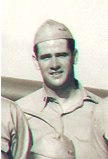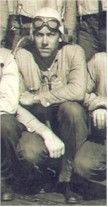
Ensign John Doherty, aboard Enterprise, January 1942.
History:
Prewar -
1941 -
1942 -
1943 -
1944 -
1945 -
Postwar
The Ship -
All Hands -
Decorations -
Remembrance
 Ensign John Doherty, aboard Enterprise, January 1942. |
The following article has been generously provided by Daniel Rush, of Oak Harbor, Washington. Mr. Rush's Great Uncle, John Doherty, was born in Boston, MA in 1921, and enlisted in the U.S. Navy in June 1940. After training in Pensacola, FL, Ensign Doherty was attached to Enterprise Air Group's Bombing Six, shortly after Pearl Harbor.
On February 1, 1942, Ensign Doherty and his gunner, Will Hunt, were shot down during the first U.S. carrier strike of the war, over Taroa, in the Marshall Islands.
"Only Ensign Jack Doherty, who, at the tail of the formation, had fought and flown desperately to keep the fighters off the other planes, and then pressed home his own attack, failed to return. His last words as his Dauntless twisted and turned among three Nakajimas were: 'These goddamn Japs will never get me.'"
- The Big E
My name is Daniel Rush. I'm currently based at Naval Air Station Whidbey Island in Washington State and have been on active duty since 1985. Family history and patriotism have always been important to my family, especially with our long service to the country. It was my mother's brother, Daniel J. Smith, who nurtured the value of remembering, of paying homage and respect to our veterans, of keeping alive the storied memories of those who gave their lives in the great battles of World War II. My Great Uncle John was the son of Irish immigrants who had settled into the projects of St. Francis Parish in Charlestown, Massachusetts. John was one of two boys who would leave the family for the Navy in 1940. His younger brother, Sonny Francis, became a seaman aboard the cruiser USS San Francisco while John entered the naval reserve as an aviation cadet. John was assigned to Bombing Six after the attack on Pearl Harbor and flew in the Enterprise's first offensive attack against Japan on February 1, 1942 over the Marshall Islands. Both he and his rear seat gunner were killed.
For many years, the story remained a simple chapter in a few books. Time and two generations later had reduced John from a living man to a one page myth. His medals have long since been lost as well as his flight log. For years, I had wanted to know so much more about John but Navy duties kept me from seeing my Uncle Sonny. He died from cancer in December of 1990. With the finding of USS Yorktown by Doctor Robert Ballard and the release of Saving Private Ryan in 1998, I was motivated by the realization that time was running out. Every day, America loses more of her World War II veterans. Gone with them are the stories that need to be preserved, not of great battles or great leaders, but of individual men and women who make up the most remarkable group of people the world will ever know. It's not just important to remember the names when they're gone, it's also important that their lives be told and why they were willing to give them up in a desperate fight to rescue a world gone mad.
Only a scant handful of veterans from the Black Rams (VB-6) survive in 1999. One of them is the last living command officer of the Battle of Midway, Dick Best. Another was John's roommate on Enterprise, retired Captain Thomas Schneider. And a backseat Dauntless radioman and gunner, Stuart Mason.
 Ensign Doherty's gunner, AOM 3/c William Hunt. |
In 1999, I decided to try contacting the last few vets from VB-6, after the famous oceanographer Dr. Robert Ballard found the remains of USS Yorktown in 1998. Watching the National Geographic Special on the find, I was shocked to learn that Dick Best from VB-6 was still alive and living in California. Using the Internet, I was able to get in touch with Mr. Arnold Olson of the USS Enterprise Association. Mr. Olson has been gracious and more than helpful to me over the past months. He sent me a packet of information containing the after-action report of February 1, 1942, involving the attack against the Japanese-held Marshall Islands. For the first time in 56 years, my family had the identity of John's radioman. I am still in the process of securing more information on Petty Officer Will Hunt.
Mr. Olson provided me with Dick Best's telephone number in California and from there I was able to find Tony Schneider and Admiral Roberts. Their accounts paint a picture of ordinary American citizens thrown into a fight for their very lives. Young men who lived, loved, dreamed, and played as any person in their youth would rightly do so. They represented another era of America so very different from today: they came from a world locked in a deadly embrace of death and destruction, a world whose very future rested on their very shoulders. No wonder I had to sit and compose myself for a moment. In 12 years of Naval service, from standing above the battered wreck of the USS Arizona, to attending a re-enlistment ceremony on the surrender deck of the USS Missouri in Bremerton, to walking the streets of Hiroshima, my journey over the battlefields of the Pacific had come down to a single phone call and back across 56 years of time.
Dick Best told me, "I have been blessed with a long and happy life, certainly lived longer than some expected." Best is a simple man, an unassuming hero who never brags or suffers from blown ego. To talk with him, it seems impossible that on a June day in 1942 he led a group of Dauntless dive bombers against the cream of the Imperial Japanese Navy.
Best was a graduate of the Naval flight school in Pensacola, Florida in early 1939 and was assigned to the Black Rams in late 1940. At that time, the war in Europe raged and among the pilots in Enterprise there seemed to be an expectation, almost an assured feeling, that war would soon come to the United States. Pearl Harbor was an unexpected start, the news sending shock at first, then outright rage. My Great Uncle John also joined the Rams in 1940. Best remembered that like all the other pilots, John had a "Get the bastards" attitude.
"John was a good man, very obedient, dedicated, clean cut. He was serious on duty. Now off duty, he was just like the other young guys in the squadron. They all had their moments. His best one was when we were docked in Pearl in mid-'41. He got caught by shore patrol running nude out of the old Monaloua Hotel. It was the only problem I ever had out of him. After Pearl, he had a real go get the bastards attitude. He never swore in public, maintained a sharp uniform, and stopped to do the sign of the cross before slipping into his plane."
Best participated in the first of two strikes on February 1, 1942 against the Marshall Islands, including runs against the Japanese airfield on Maloelap. He remembers clearly, the moment of each squadron loss from Pearl Harbor to Midway. "I was in the ready room when they told me John had been lost. Every loss hurt, as it rightly should. Commander Hollingsworth wrote the citation and personal letter that got routed through the chain to John's parents back home. Later that night, Tony Schneider came by my stateroom with a personal letter that had to go through censorship channels. It was addressed to John's mother from Tony, telling her about his friendship with John and, well ... it was written well enough to get through intact."
Best defines Midway: "It was the single, most enduring example of courage, bravery, and sacrifice ever shown by the US Navy." He is not short in the classic thinking that Midway was a win or lose by the hair battle with plenty of foul-ups, mistakes, misjudgments, confusion, and dumb luck to grant it historical value. Best led Bombing Six in attacking the lead carrier of the Japanese battle group, the Akagi, and was surprised by the picture-perfect conditions offered to him as his Dauntless rolled in for the bomb run.
"Here we were, clear sky, fair seas, and below my sight was the Akagi. Her deck was painted a very light yellow and a huge red dot sat on the bow of the flight deck. That was my aim point, I set my hairs right on that meatball and let loose at around 1,800 feet. I pulled out and rolled over so close to that ship that the Japanese could have thrown a monkey wrench at me. The whole back end seemed to erupt in this big ball of smoke and fire."
The Akagi did "erupt." Best and his pilots had caught her cold with tons of bombs and torpedoes carelessly left topside along with fueling carts and loaded attack planes. This "hell's casserole" instantly turned Akagi into a flaming wreck. Best gives both lasting credit and a deep sense of sad respect to the many torpedo plane crews who were killed at Midway. The most devastating losses came from the USS Hornet which lost all but one man of its attacking TBD squadron. "Those poor guys went in without fighter cover in planes that were no match for the Japanese. They could have waited but they chose to go in and they got mauled. Their acts of sacrifice lowered the Japanese guard, brought down the anti-aircraft and fighter cover from high angle to sea level and we came in and nailed them good. Those guys won Midway for us, they won it with their own lives."
For Dick Best, however, Midway ended his flight career. His oxygen supply during the final attack of the battle was soured. The mixture burned his lungs and could have killed him had he not acted fast in diving to breathing altitude. He was discharged from the Navy in late 1942 and has lived ever since in Santa Monica, California.
So what caused the Japanese defeat at Midway? Best credits overconfidence. "They were doing so good up to that point and the Japanese Navy was one that earned respect, they put up a damn good fight. But from Pearl Harbor to Midway, they just allowed overconfidence to run them over."
Best also credits the commanders of the day. Halsey has his most undying praise. "I remember after Pearl when all the pilots were called into hangar one to get a pep talk from the old man. Halsey won respect not with his good looks, he truly looked like a bulldog, but with his attitude. He clearly carried the emotions of everyone with this speech..."
"True, the Japs got lucky at Pearl gentlemen, but it will be and is their downfall. We are going to fight vigorously and viciously until we've drilled them into the God damn ground!"
"That mirrored Halsey in everything he did, in every operation he led. Right from the start of the war, he grew a 'Get them' attitude in the Enterprise crew from the lowest black gang kid to the Captain. January through June of '42 was the pivot on which our efforts rested and Halsey knew it well. Nimitz may be the most well-known admiral in the Navy but damn if Halsey isn't the best we ever had period."
Image Library -
Action Reports and Logs -
News Stories
Message Boards -
Bookstore -
Enterprise CV-6 Association
Copyright © 1998-2003 Joel Shepherd ([email protected])
Sources and Credits